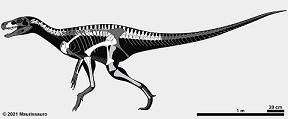
Sanjuansaurus is an intriguing Dinosaur from the Late Triassic period, approximately 215 million years ago. It belongs to a group of early theropods, which are a diverse group of carnivorous dinosaurs that includes famous relatives like Tyrannosaurus rex. In this 500-word exploration, we will delve into its classification, physical characteristics, habitat, behavior, and its significance in the world of paleontology.
Sanjuansaurus is classified as a theropod dinosaur, specifically within the family Herrerasauridae. These early theropods are of great interest to paleontologists because they provide valuable insights into the early evolution of dinosaurs.
| Name: | Sanjuansaurus dinosaurs |
| Size: | Around 10 to 13 feet (3 to 4 meters) in length. |
| Main Facts: | Sanjuansaurus , an early theropod, inhabited Late Triassic South America, providing clues to the early evolution of carnivorous dinosaurs. |
The first fossils of Sanjuansaurus were discovered in the Ischigualasto Formation of Argentina, which is renowned for its rich deposits of Triassic fossils. These fossils, dating back to the Late Triassic, include partial skeletal remains that have contributed to our understanding of this ancient dinosaur.

Sanjuansaurus was a relatively small dinosaur, measuring approximately 10 to 13 feet (3 to 4 meters) in length. Some of its key physical characteristics include :
Like all theropods, Sanjuansaurus walked on two legs, a characteristic feature of this dinosaur group.
Sanjuansaurus was a carnivore, possessing sharp teeth adapted for tearing flesh. Its diet likely consisted of small vertebrates and other animals present in its ecosystem.
As an early theropod, Sanjuansaurus exhibited features that distinguish it from more advanced theropods. These features include a more primitive hip structure and limb proportions.
Its most distinctive feature was its small, slender head and beak, which was lined with serrated teeth that it used to tear apart tough vegetation.
Sanjuansaurus lived during the Late Triassic period, a time when the Earth was experiencing significant changes in its flora and fauna. The Ischigualasto Formation in Argentina, where its fossils were found, was characterized by semi-arid conditions and a range of unique creatures.
Sanjuansaurus holds significance in the field of paleontology for several reasons :
As one of the early theropods, Sanjuansaurus provides crucial information about the evolutionary history of this dinosaur group. It offers insights into the early diversification of theropods and their emergence as dominant predators.
Fossils of Sanjuansaurus contribute to our understanding of the Late Triassic ecosystems in South America. This period marked a pivotal time in Earth's history, with the appearance of various dinosaur lineages and the decline of some reptilian groups.
Studying early theropods like Sanjuansaurus helps paleontologists trace the evolutionary pathways that eventually led to the emergence of larger and more specialized theropods, including the iconic predators of later periods.
Sanjuansaurus, an early theropod from the Late Triassic, measured around 10-13 feet in length. It had a bipedal stance, sharp teeth adapted for carnivory, and a relatively primitive hip structure compared to later theropods. Fossils discovered in Argentina's Ischigualasto Formation have provided insights into this ancient predator.
Sanjuansaurus inhabited semi-arid Late Triassic ecosystems and likely preyed on smaller vertebrates in its competitive environment. As an early theropod, it plays a significant role in understanding the evolutionary history and adaptations of these carnivorous dinosaurs during a pivotal period in Earth's history.
Comparing Sanjuansaurus to other dinosaurs, particularly other theropods, highlights the unique features and evolutionary context of this early carnivorous dinosaur:
Sanjuansaurus, like other theropods, shares the bipedal stance and carnivorous diet that define this dinosaur group. Its sharp teeth and predatory adaptations are common among theropods.
Sanjuansaurus coexisted with a variety of dinosaurs and reptiles during the Late Triassic period. Its presence reflects the emergence of different dinosaur lineages during this era.
Sanjuansaurus represents an early stage in theropod evolution. Compared to later theropods like Tyrannosaurus rex or Velociraptor, it exhibits more primitive characteristics in its hip structure and limb proportions.
Sanjuansaurus was relatively small, measuring about 10-13 feet in length. In contrast, later theropods included giants like Tyrannosaurus rex, which reached lengths of up to 40 feet.
Unlike some later theropods known for their powerful tails (e.g., Spinosaurus), Sanjuansaurus did not possess specialized tail adaptations.
Sanjuansaurus lived in South America during the Late Triassic, while other theropods inhabited various continents in different time periods. For example, Tyrannosaurus rex lived in North America during the Late Cretaceous.
As an early theropod, Sanjuansaurus likely occupied a different ecological niche than its later counterparts. It may have preyed on different types of animals and interacted with a distinct set of species in its ecosystem.